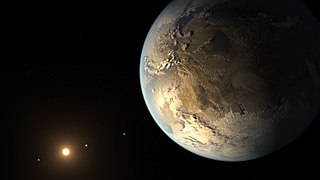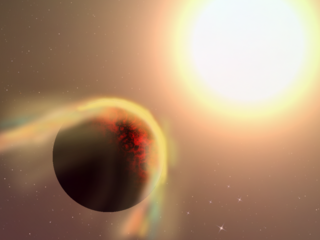Related Research Articles

An exomoon or extrasolar moon is a natural satellite that orbits an exoplanet or other non-stellar extrasolar body.

These are lists of exoplanets. As of 19 December 2023, there are 5,566 confirmed exoplanets in 4,140 planetary systems, with 942 systems having more than one planet. Most of these were discovered by the Kepler space telescope. There are an additional 1,984 potential exoplanets from Kepler's first mission yet to be confirmed, as well as 977 from its "Second Light" mission and 4,589 from the Transiting Exoplanet Survey Satellite (TESS) mission.
This page describes exoplanet orbital and physical parameters.

Kepler-9b is one of the first planets discovered outside the solar system (exoplanets) by NASA's Kepler Mission. It revolves around the star Kepler-9 within the constellation Lyra. Kepler-9b is the largest of three planets detected in the Kepler system by transit method; its mass is roughly half that of the planet Saturn, and it is the largest planet in its system. Kepler-9b and Kepler-9c display a phenomenon called orbital resonance, in which gravitational pull from each planet alters and stabilizes the orbit of the other. The planet's discovery was announced on August 26, 2010.

Kepler-9c is one of the first seven extrasolar planets, exoplanets, discovered by NASA's Kepler Mission, and one of at least two planets orbiting the star Kepler-9. Kepler-9c and Kepler-9b were the first exoplanets confirmed to be transiting their star. The planet's discovery was announced by the Kepler Mission team on August 26, 2010 after its initial discovery by Kepler. At the time, it was one of 700 planetary candidates noted by Kepler.

An exoplanet is a planet located outside the Solar System. The first evidence of an exoplanet was noted as early as 1917, but was not recognized as such until 2016; no planet discovery has yet come from that evidence. What turned out to be the first detection of an exoplanet was published among a list of possible candidates in 1988, though not confirmed until 2003. The first confirmed detection came in 1992, with the discovery of terrestrial-mass planets orbiting the pulsar PSR B1257+12. The first confirmation of an exoplanet orbiting a main-sequence star was made in 1995, when a giant planet was found in a four-day orbit around the nearby star 51 Pegasi. Some exoplanets have been imaged directly by telescopes, but the vast majority have been detected through indirect methods, such as the transit method and the radial-velocity method. As of 1 December 2023, there are 5,550 confirmed exoplanets in 4,089 planetary systems, with 887 systems having more than one planet. This is a list of the most notable discoveries.

Kepler-16b is an exoplanet. It is a Saturn-mass planet consisting of half gas and half rock and ice, and it orbits a binary star, Kepler-16, with a period of 229 days. "[It] is the first confirmed, unambiguous example of a circumbinary planet – a planet orbiting not one, but two stars," said Josh Carter of the Center for Astrophysics | Harvard & Smithsonian, one of the discovery team.

Kepler-70b is one of two postulated exoplanets orbiting the subdwarf B star (sdB) Kepler-70. The other planet is Kepler-70c, and both planets orbit very close to their host star.
Kepler-70c is one of two postulated exoplanets orbiting the sdB star Kepler-70. Their discovery was announced in 2011. However, later research suggests that the two exoplanets probably do not exist, and that "pulsation modes visible beyond the cut-off frequency of the star" were a more likely explanation for the signals believed to indicate exoplanets. This is not proven with certainty one way or the other.

Kepler-90, also designated 2MASS J18574403+4918185, is a G-type star located about 2,790 light-years (855 pc) from Earth in the constellation of Draco. It is notable for possessing a planetary system that has the same number of observed planets as the Solar System.

Kepler-186 is a main-sequence M1-type dwarf star, located 178.5 parsecs away in the constellation of Cygnus. The star is slightly cooler than the sun, with roughly half its metallicity. It is known to have five planets, including the first Earth-sized world discovered in the habitable zone: Kepler-186f. The star hosts four other planets discovered so far, though they all orbit interior to the habitable zone.
Kepler-440b is a confirmed super-Earth exoplanet orbiting within the habitable zone of Kepler-440, about 850 light-years (261 pc) from Earth. The planet was discovered by NASA's Kepler spacecraft using the transit method, in which the dimming effect that a planet causes as it crosses in front of its star is measured. NASA announced the confirmation of the exoplanet on 6 January 2015.
Kepler-444 is a triple star system, estimated to be 11.2 billion years old, approximately 119 light-years (36 pc) away from Earth in the constellation Lyra. On 27 January 2015, the Kepler spacecraft is reported to have confirmed the detection of five sub-Earth-sized rocky exoplanets orbiting the main star. The star is a K-type main sequence star. All of the planets are far too close to their star to harbour life forms.

Kepler-1647b is a circumbinary exoplanet that orbits the binary star system Kepler-1647, 3,700 light-years (1,100 pc) from Earth in the constellation Cygnus. It was announced on June 13, 2016, in San Diego at a meeting of the American Astronomical Society. It was detected using the transit method, when it caused the dimming of the primary star, and then again of the secondary star blended with the primary star eclipse. The first transit of the planet was identified in 2012, but at the time the single event was not enough to rule out contamination, or confirm it as a planet. It was discovered by the analysis of the Kepler light-curve, which showed the planet in transit.
Kepler-124b is an extrasolar planet discovered in 2014. It is located 359 parsecs from Earth, orbiting the unclassified star Kepler-124 in the constellation Cygnus. Within The Kepler-124 system (KOI-241) there are three known planets, Kepler-124b being both the smallest and closest to its parent star.
Kepler-1652b is a super-Earth exoplanet, orbiting within the habitable zone of the red dwarf Kepler-1652 about 822 light-years away in the Cygnus constellation. Discovered by NASA's Kepler spacecraft, Kepler-1652b was first announced as a candidate in 2013, but wasn't validated until four years later in 2017. It is a potential super-Earth with 160% Earth's radius. The planet orbits well within the habitable zone of its system, the region where liquid water can exist on a planet's surface. The planet is an eyeball planet candidate.
Kepler-1544b is a potentially habitable exoplanet announced in 2016 and located 1138 light years away, in the constellation of Cygnus.
K2-66b is a confirmed mega-Earth orbiting the subgiant K2-66, about 520 parsecs (1,700 ly) from Earth in the direction of Aquarius. It is an extremely hot and dense planet heavier than Neptune, but with only about half its radius.
References
- 1 2 3 "Kepler-186 b". NASA Exoplanet Archive. Retrieved 29 December 2016.
- ↑ "The Extrasolar Planet Encyclopaedia — Kepler-186 B". Extrasolar Planets Encyclopaedia .
- ↑ "The Extrasolar Planet Encyclopaedia — Kepler-186 B". Extrasolar Planets Encyclopaedia .
